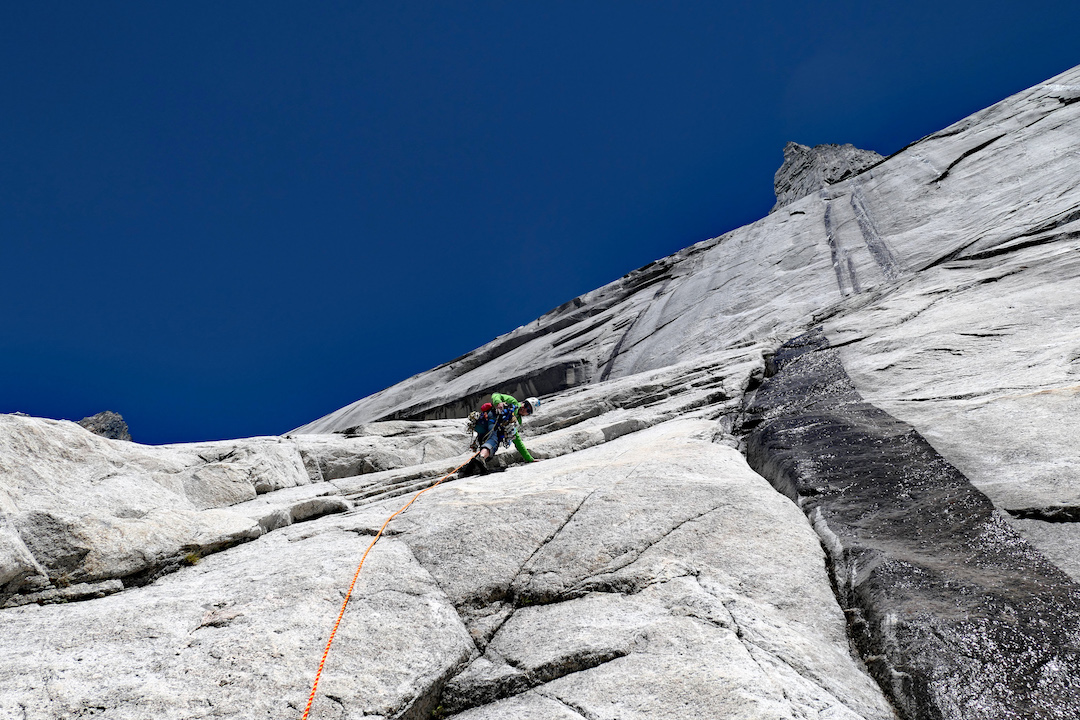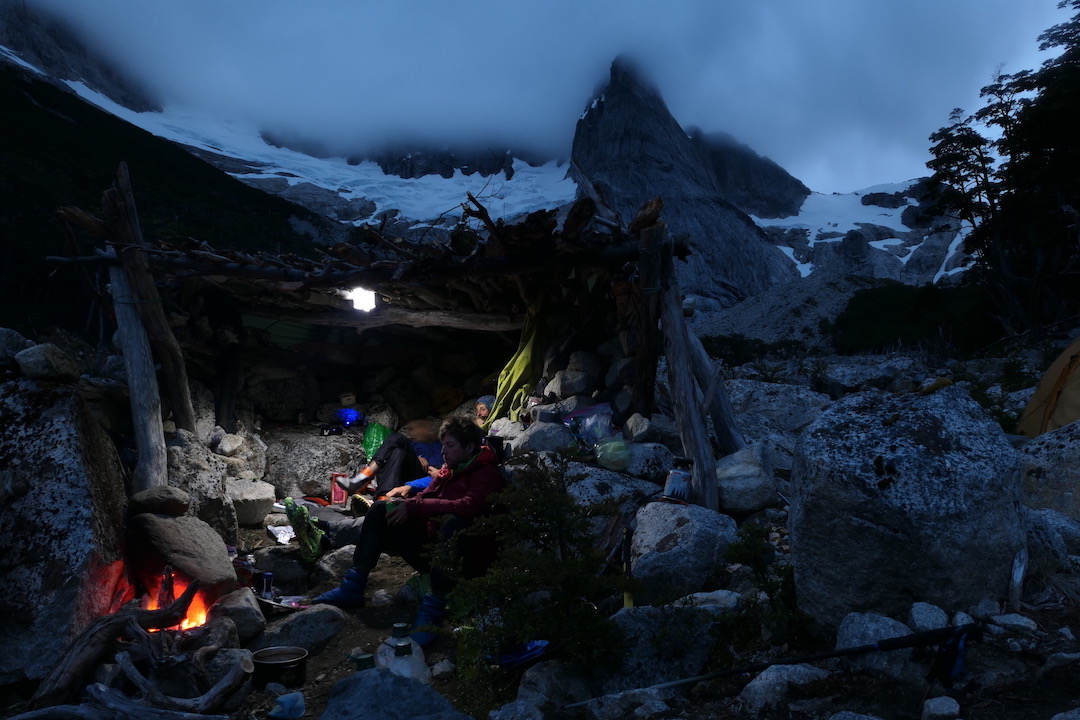Avellano Towers, South Avellano Tower, East Face
Chile, Northern Patagonia, Aysén Region

FAR FROM the ever-connected hustle of modern life, deep in the heart of northern Chilean Patagonia, the pristine granite faces and snowy caps of the Avellano Towers rise up from a hidden valley at the head of the Avellano River. They say the best things come to those who wait, which is good, seeing as this was to be my third attempt on a virgin wall among the Avellano Towers!
The legend Jim Donini was good enough to introduce Dave Brown and me to this spectacular area several years ago. On that first trip, back in February 2014 (see AAJ 2015), we had the privilege of kicking off the week with a 300m first ascent on the Tooth with Jim. What we saw across from us, however, almost made our jaws hit the ledge. There stood a pristine wall of monstrous proportions—the east face of South Avellano Tower—which to our knowledge had never even been attempted. How big? We didn’t know, but we had to try.
We left a bivy in the middle of the night with enough food and water to stretch our attempt to two days if necessary. We’d optimistically scoped a line of continuous-looking grooves leading to the halfway ledges and began with gusto. The glacially polished granite was of El Cap quality but smoother than expected—before long we were lowering to the ground. Before dawn we had attempted to follow another groove but met with the same fate. Our third attempt got us onto the face, but featured a circuitous route in which little altitude was gained, forcing us to abort. The afternoon was spent staring up at the monolith that had repelled us, realizing we were going to need reinforcements.
Dave and I returned in December of that same year with Andy Reeve and Will Harris to attempt a direct line up the center of the face. Our approach was altogether heavier and required us to explore a new approach from the one Jim had shown us.

This time we crossed the huge, rough Lago General Carrera in a small, overloaded boat, after which gauchos and their horses took our gear 30km up the beautiful Avellano River valley from the southeast. We then made multiple load carries through glacial rivers, marsh, forest, and moraine. Things started well, but unfortunately our first attempt was thwarted by a cold storm that left icy ghosts guarding the face.
Returning to collect our gear, we found our first 80m fixed rope was missing! A car-size flake had peeled off from high on the wall, slicing through the rope and leaving blocks strewn all over the ledges. Dave made a heroic lead through a huge roof crack with only half a set of cams and wires to gain the lines above and recover our gear in a torrential downpour. We gave up on any further attempts that year. [Editor’s note: An American expedition in January 2015 also made an attempt on this face, but was turned around after 400m. See AAJ 2016.]

Arriving back in the area in January 2018 for the third attempt felt great. This time I was accompanied by John McCune, Will Sim, Paul Swail, and my girlfriend, Ruth Bevan. Jim Donini and his wife Angela’s limitless hospitality makes returning to one of the biggest wilderness areas in the world like popping by to see old friends. Following much poor weather in December, conditions gradually improved the closer we got to the wall. Our base camp was idyllic, with running water and plenty of wood nearby. A lean-to well-built by my partners made for extra comfort and a sociable shelter, while cooking lessons from Ruth made for excellent eating. By the time camp was fully established, the wall was more or less dry enough to climb.
We made quick progress on my original line, setting ropes to the halfway ledges over the first two days. These pitches follow a soaring line of cracks and grooves through a perfectly smooth shield of rock, allowing a spectacular passage of only moderate difficulty through several roofs. Poor weather threatened to move in by the end of the next day, so we made the decision to go for it immediately.
We gained the top of the fixed ropes by daybreak and attacked the headwall in two pairs. The rock became more varied, with some loose flakes and areas of exfoliating rock. There was a lot of incredibly high-quality climbing and sensational positions. The main weakness centered around a huge corner system, but after a couple of damp pitches, we were forced to quit this. I followed steep and strenuous cracks up the left wall to a ledge, before looking up in dismay at what looked like a dead-end. Paul then quested up a steep groove, overcoming increasingly unlikely terrain. After managing to place a peg in a very awkward position, he made steep moves through a roof on chicken heads, leading to an outrageously exposed traverse that brought us back to the top of the corner.
From here I made a long, bold traverse back right over compact black rock to reach a viable-looking groove. An intricate pitch led to some burly laybacking around a roof, and before too long we were pulling onto the north face, where easy ground led to a final ramp. This provided a great finale, with 200m of high-quality, straightforward climbing. We topped out around 5 p.m., with the rising Patagonian winds already threatening to sweep us from the summit. Ruth traced our progress from base camp, with radio contact throughout, watching as it began to rain halfway through our descent and preparing a roaring fire, pumpkin curry, and cheesecake for our return!

I was ecstatic but almost in shock that we’d climbed the wall so quickly! I was helped by a class A team of alpinists. We came prepared for a big-walling adventure, armed with portaledges and aid gear, but in the end we did what we do best and smashed it out before the bad weather came in an adventurous free-climbing push. All pitches were led free by at least one of us. After three trips, the east face of South Avellano Tower (900m, E5 6a/5.11d) was complete.

Our quick ascent left plenty of time for other climbs around the valley, including adventures with Ruth. We climbed three more routes between the five of us, including the Last Gaucho (E5 6B) and a variation to that route on a formation we began calling "Cerro Square Face," northeast of the main towers, and a brilliant easier face, Chicken Run (600m, E2), on an unnamed formation adjacent to Square Face.
– John Crook, U.K.


















